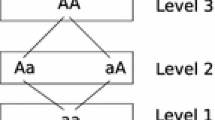Abstract
Motivated by the observation that vagueness often involves a shift of underlying granularity levels, we introduce models of quantifiers like ‘about one half’, ‘roughly 10%’, etc., that refer to granules of proportionality levels. Corresponding (partial) truth functions are extracted from rough set based models, which may then be systematically mapped into corresponding fuzzy quantifier models.
C. G. Fermüller — This work is supported by Austrian Science Fund (FWF) grant I1827-N25.
Access this chapter
Tax calculation will be finalised at checkout
Purchases are for personal use only
Similar content being viewed by others
Notes
- 1.
Of course, linguists and philosophers recognize the importance of emphasis, hedging, uncertainty, etc., as triggered by vagueness. However these phenomena are modeled beneath or in addition to the outer level of communication via declarative statements.
- 2.
Recall from Sect. 2 that we identify domain elements with constant symbols.
- 3.
Not every such function is admitted as meaning of a logical quantifier. We focus on proportional quantifiers here, which are definitely to be classified as logical.
- 4.
Modifiers like \(\textsf {approximately}\) (\(\approx \)) are usually left implicit when communicating by asserting sentences like 10% of the population lives in poverty.
- 5.
References
Delgado, M., Ruiz, M.D., Sánchez, D., Vila, M.A.: Fuzzy quantification: a state of the art. Fuzzy Sets Syst. 242, 1–30 (2014)
Fermüller, C.G.: Combining fuzziness and context sensitivity in game based models of vague quantification. In: Huynh, V.-N., Inuiguchi, M., Denoeux, T. (eds.) IUKM 2015. LNCS (LNAI), vol. 9376, pp. 19–31. Springer, Cham (2015). https://doi.org/10.1007/978-3-319-25135-6_4
Fermüller, C.G., Hofer, M., Ortiz, M.: Querying with vague quantifiers using probabilistic semantics. In: Christiansen, H., Jaudoin, H., Chountas, P., Andreasen, T., Legind Larsen, H. (eds.) FQAS 2017. LNCS (LNAI), vol. 10333, pp. 15–27. Springer, Cham (2017). https://doi.org/10.1007/978-3-319-59692-1_2
Fermüller, C.G., Roschger, C.: Randomized game semantics for semi-fuzzy quantifiers. Logic J. IGPL 223(3), 413–439 (2014)
Fine, K.: Vagueness, truth and logic. Synthese 30(3), 265–300 (1975)
Giles, R.: A non-classical logic for physics. Stud. Logica 33(4), 397–415 (1974)
Glöckner, I.: Fuzzy Quantifiers: A computational Theory. Studies in Fuzziness and Soft Computing, vol. 193. Springer, Heidelberg (2006). https://doi.org/10.1007/3-540-32503-4
Krifka, M.: Approximate interpretation of number words: A case for strategic communication. In: Hinrichs, E., Nerbonne, J. (eds.) Theory and Evidence in Semantics, pp. 109–132. CSLI Publications, Stanford (2009)
Lawry, J.: A voting mechanism for fuzzy logic. Int. J. Approximate Reasoning 19(3–4), 315–333 (1998)
Liu, Y., Kerre, E.E.: An overview of fuzzy quantifiers (I) Interpretations. Fuzzy Sets Syst. 95(1), 1–21 (1998)
Pawlak, Z.: Vagueness and uncertainty: a rough set perspective. Comput. Intell. 11(2), 227–232 (1995)
Pawlak, Z., Grzymala-Busse, J., Slowinski, R., Ziarko, W.: Rough sets. Commun. ACM 38(11), 88–95 (1995)
Shapiro, S.: Vagueness in Context. Oxford University Press, Oxford (2006)
Smith, N.J.J.: Vagueness and Degrees of Truth. Oxford University Press, Oxford (2008)
Sorensen, R.: Vagueness and Contradiction. Clarendon Press, Oxford (2001)
Vetterlein, T.: Vagueness: a mathematicians perspective. In: Cintula, P., et al. (eds.) Understanding Vagueness - Logical, Philosophical and Linguistic Perspectives, pp. 67–86. College Publications (2011)
Vetterlein, T.: Logic of prototypes and counterexamples: possibilities and limits (2015). https://www.atlantis-press.com/proceedings/ifsa-eusflat-15/
Williamson, T.: Vagueness. Routledge, London (2002)
Yao, Y.Y.: A comparative study of fuzzy sets and rough sets. Inf. Sci. 109(1–4), 227–242 (1998)
Yao, Y.Y.: Information granulation and rough set approximation. Int. J. Intell. Syst. 16(1), 87–104 (2001)
Zadeh, L.A.: A computational approach to fuzzy quantifiers in natural languages. Comput. Math. Appl. 9(1), 149–184 (1983)
Author information
Authors and Affiliations
Corresponding author
Editor information
Editors and Affiliations
Rights and permissions
Copyright information
© 2018 Springer International Publishing AG, part of Springer Nature
About this paper
Cite this paper
Fermüller, C.G. (2018). A Granularity Approach to Vague Quantification. In: Huynh, VN., Inuiguchi, M., Tran, D., Denoeux, T. (eds) Integrated Uncertainty in Knowledge Modelling and Decision Making. IUKM 2018. Lecture Notes in Computer Science(), vol 10758. Springer, Cham. https://doi.org/10.1007/978-3-319-75429-1_1
Download citation
DOI: https://doi.org/10.1007/978-3-319-75429-1_1
Published:
Publisher Name: Springer, Cham
Print ISBN: 978-3-319-75428-4
Online ISBN: 978-3-319-75429-1
eBook Packages: Computer ScienceComputer Science (R0)




